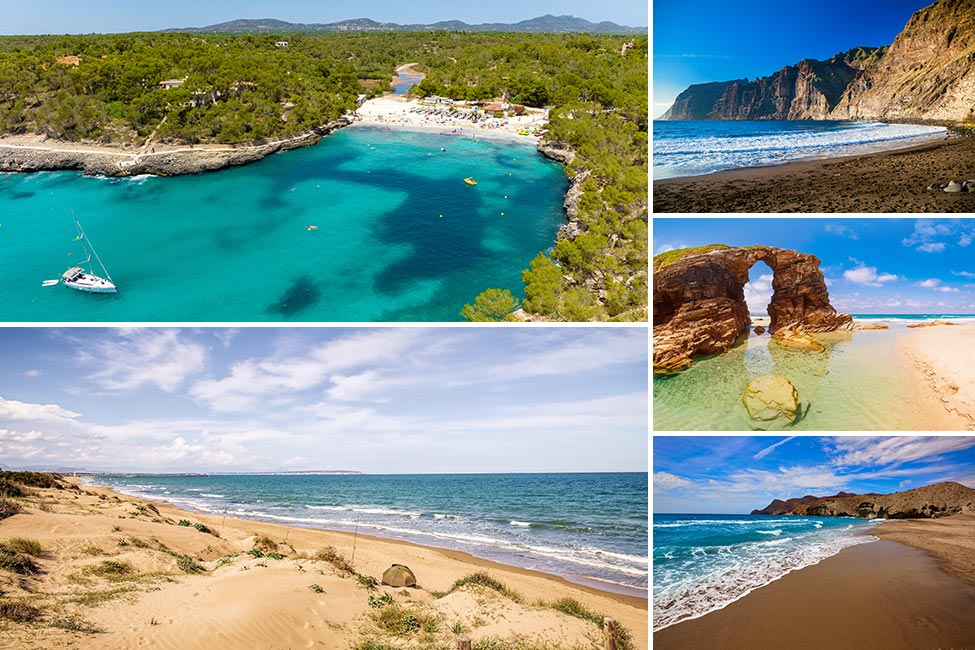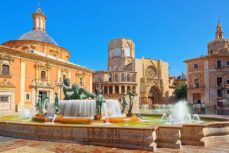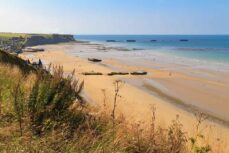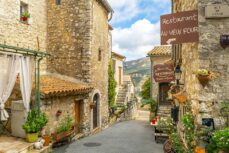The 10 most stunning beaches of Spain

Bolonia (Andalusia)
On the Costa de la Luz, the beach of the village of Tarifa lies at the meeting point of the Mediterranean Sea and the Atlantic Ocean at the southernmost tip of the Iberian Peninsula and the continent of Europe! This strategic location makes Bolonia paradise for wind and kite surfers. Even better, it boasts a huge golden sand dune that stretches out for four kilometres near the nature reserve of el Estrecho, thus guaranteeing unspoilt landscapes and panoramas.

Cala Mondragó (Balearic Islands)
Mondragó Natural Park is a protected site of coves in the south of Mallorca. The gently sloped Cala Mondragó is one of the star coves of the largest Balearic Island whose crystal-clear turquoise waters are lined by pristine white sand and rocks. Hikers adore exploring its paths that are dotted with natural pools in sheltered creeks.

Cala Turqueta (Balearic Islands)
This rugged cove is one of the most famous beaches of the island of Minorca. It lies in the heart of a stunning landscape of sweet-scented pine trees and is entirely devoid of any construction. Its transparent water is ideal for snorkelling. However, its success is such that, come summertime, we advise going early in the morning or in the late afternoon, otherwise you may well be greeted by a sign indicating “Ileno” (Full) at the entrance to the carpark.

Calella de Palafrugell (Catalonia)
With its colourful fishing boats overturned on the sand, arcaded whitewashed houses and cobbled streets, this charming seaside resort and its small beaches are lightyears from the rest of the Costa Brava. You only have to walk a short distance or head out to sea in a zodiac boat to find a quieter spot, tucked away among the rocks, even in the height of summer. The coves are home to Llafranc and Tamariu, two other equally picturesque fishing ports.

Cathedral Beach (Galicia)
The amazing natural sculptures of this beach at Ribadeo along the Cantabrian coast are most spectacular at low tide. The arches rise to a height of 30 metres and are reminiscent of a cathedral’s flying buttresses, hence its name… Some of the vaulted caves boast a ceiling in the shape of a cupola, tapering off into a spire. The spot is so famous that you have to book your trip beforehand (free of charge) on the internet, particularly at Easter and in summertime, as access is restricted to 5,000 people/day.

La Concha (Basque Country)
A shell-shaped bay encloses the iconic beach of San Sebastian, capital of the Spanish Basque Country. Its wrought-iron railings, constructed in the 1910’s, and the beach have become the emblem of the “pearl of the Cantabrian”. Four hundred metres from the coast, Santa Clara Island, which can be reached after a short swim, leaving from the neighbouring beach of Ondaretta, or by boat, commands the best view of the beautiful La Concha…

Guardamar del Segura (Valencia)
To the south of Alicante, this string of beaches lined by pine forests stretches out for ten kilometres along the Costa Brava. Planted over a century ago, the trees provide natural shelter from offshore winds in a “caliente” climate: the average temperature of this seaside resort is 17°C in winter and 29°C in summertime.

Los Gigantes (Canary Islands)
On the west coast of the island of Tenerife, Los Gigantes beach is renowned for its stunning natural panorama of black volcanic sand and high cliffs: basalt cathedrals, which tower up to a height of 600 metres. The site, famous for its deep-sea diving, is home to colourful sponges and corals; it is also a popular whale and dolphin observation spot.

Monsul Beach (Andalusia)
Eroded lava flows set the scene of this beach in Cabo de Gata nature reserve along Andalusia’s Costa del Sol. A huge rock adorns the middle of the beach, offering shade during heatwave temperatures. Entirely devoid of any human construction, with only a shifting dune to the left and access to Media Luna cove to the right, the spot is truly in a class of its own and has starred in many films, among which Stephen Spielberg’s Indiana Jones and the Last Crusade.

Ses Salines (Balearic Islands)
The most famous beach of Ibiza, at the very south of the island, is located in Ses Salines nature reserve. To get the most out of this incredible spot without the crowds, it is best to go out of season or early in the morning, when its long strip of fine white sand, lined by dunes and pine trees, is still unsullied and spotless. As the day progresses, sunbeds and parasols gradually overrun the platja and in the late afternoon, bare-footed youngsters start dancing in the sand. It remains an idyllic spot with turquoise water and Formentera Island in the background.















